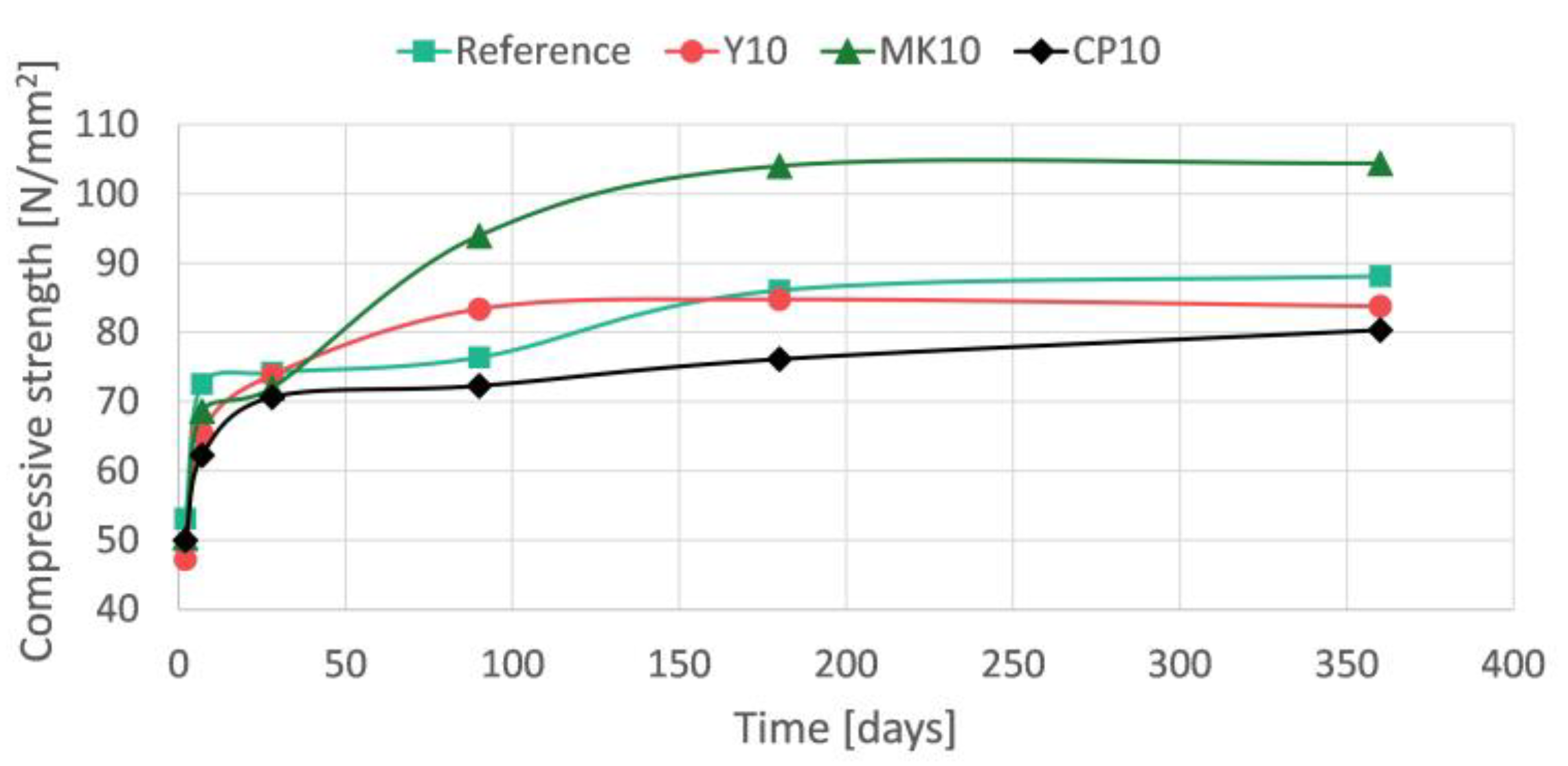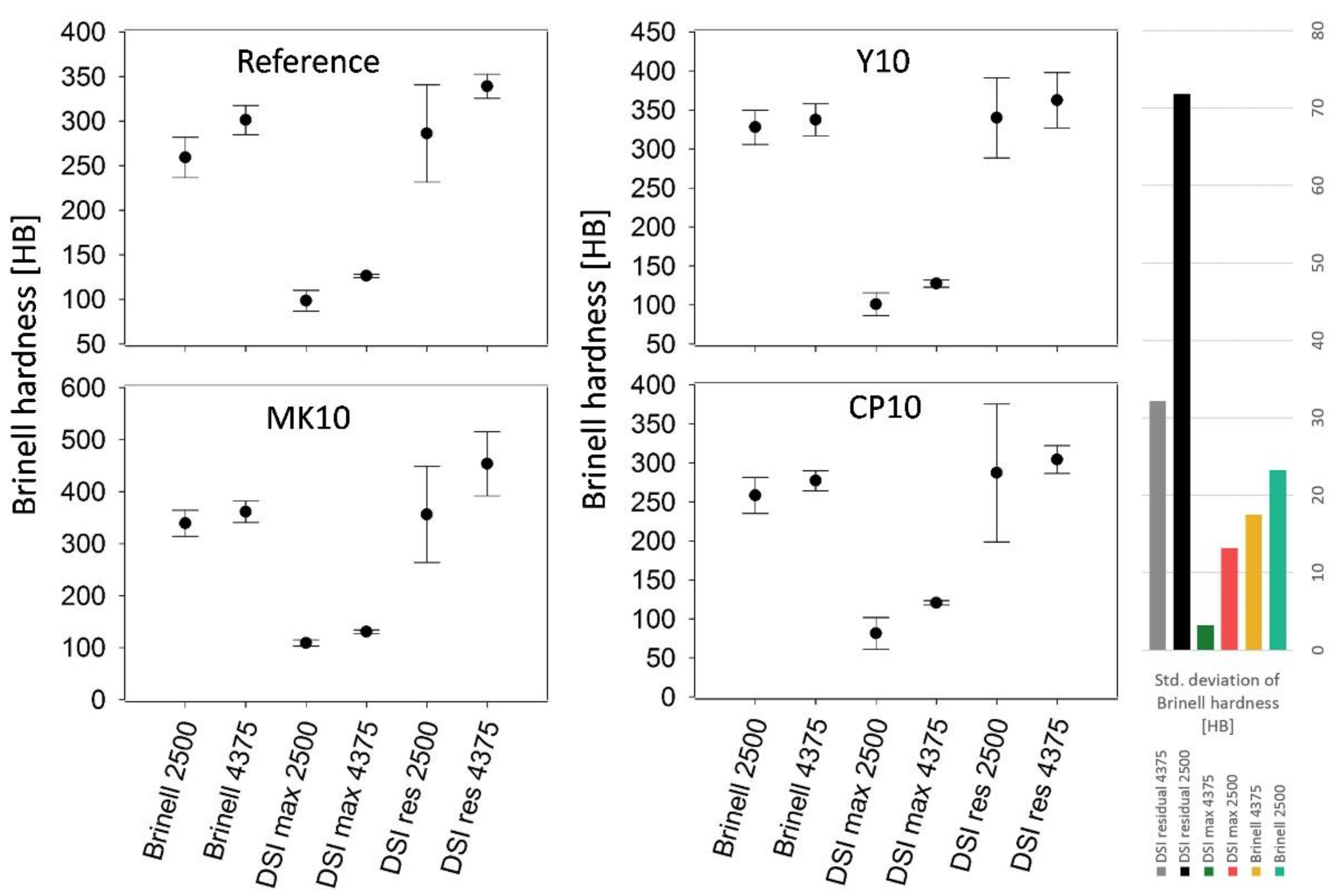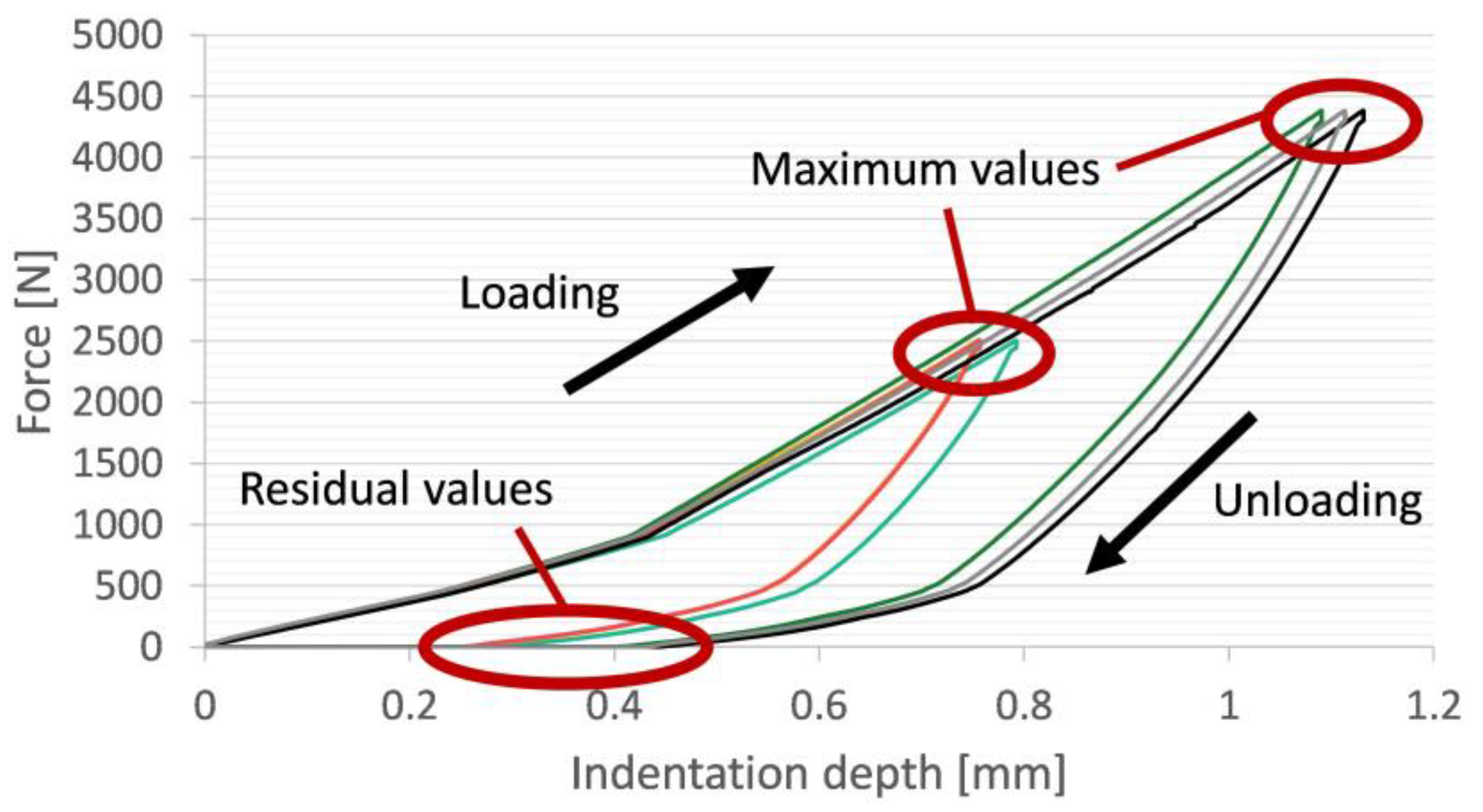Static Hardness Testing of Cement Mortars Containing Different Types of Recycled Construction Waste Powders
Abstract
:1. Introduction
- Long-term development of the compressive strength (up to one year) of cast specimens was studied, and the hardening process of the different samples was monitored.
- Specimens were subjected to DSI and Brinell hardness tests, and the results were analyzed on the bases of deformation, hardness, and energy.
2. Materials and Methods
3. Results and Discussion
3.1. Compressive Strength Test Results
3.2. Non-Destructive Test Results
- Brinell: 0.19 and 0.16 mm;
- DSI maximum: 0.40 and 0.09 mm;
- DSI residual: 0.51 and 0.29 mm.
4. Conclusions
- Based on thermogravimetric analysis, it was determined that neither the aerated concrete powder nor the concrete powder works as a traditional SMC (such as metakaolin); there is no sign of chemical reactions (hydraulic reactions). However, aerated concrete powder swells during the hardening of the mortar, which makes it a beneficial filling material until its particles are small enough (based on our measurement dmax < 0.09 mm). The CP does not show any sign of these chemical reactions during the hardening of the mortar; it could be considered as an inert material in the mix.
- The long-term compressive strength tests showed that all applied recycled additives are influencing the hardening process of the mortar; however, after 360 days of age, their compressive strength was close to the reference mortar (CP10 was lower ~10%; Y10 was lower ~5%). By taking into account that these are recycled waste materials, from an environmental point of view, they are more advantageous and do not significantly affect the performance of the mix; it can be concluded that they could be applicable on a larger scale as well.
- The hardness test results from both the Brinell and DSI tests unanimously indicated that on a higher load level (4375 N in the present case), the standard deviation of the results (indentation diameter / Brinell hardness) is lower. In case of MK10 and CP10, the change in the compressive strength (compared to the reference) was followed by the hardness test results. However, in case of the Y10 mortar, the compressive strength decreased, while the measured Brinell hardness increased. This can be explained by the filler effect of aerated concrete powder, which increased the surface hardness of the samples.
- The hardness results were analyzed on an indentation energy basis, using the data available from the DSI tests. The analysis showed that all materials could be considered to be elastoplastic material. It was found that the aerated concrete powder has no effect on the total indentation energy, while the metakaolin increases it, and the concrete powder decreases it, that correlates with their hardness values compared to the reference mix.
- The analysis also highlighted that the change in the hardness value is connected to the elastic indentation energy, while it is seemingly independent from the dissipated (plastic) indentation energy. This indicates that the change in the compressive strength caused by additives influences the elastic properties of the material.
Author Contributions
Funding
Institutional Review Board Statement
Informed Consent Statement
Data Availability Statement
Conflicts of Interest
References
- Aprianti, E. A huge number of artificial waste material can be supplementary cementitious material (SCM) for concrete production e a review part II. J. Clean. Prod. 2017, 142, 4178–4194. [Google Scholar] [CrossRef]
- Topcu, I.B.; Güncan, N.F. Using waste concrete as aggregate. Cem. Concr. Res. 1995, 25, 1385–1390. [Google Scholar] [CrossRef]
- Topcu, I.B.; Sengel, S. Properties of concretes produced with waste concrete aggregate. Cem. Concr. Res. 2004, 34, 1307–1312. [Google Scholar] [CrossRef]
- Borosnyói, A. Long term durability performance and mechanical properties of high performance concretes with combined use of supplementary cementing materials. Constr. Build. Mater. 2016, 112, 307–324. [Google Scholar] [CrossRef]
- Yu, R.; Shui, Z. Efficient reuse of the recycled construction waste cementitious materials. J. Clean. Prod. 2014, 78, 202–207. [Google Scholar] [CrossRef] [Green Version]
- Zhang, J.; Ding, L.; Li, F.; Peng, J. Recycled aggregates from construction and demolition wastes as alternative filling materials for highway subgrades in China. J. Clean. Prod. 2020, 255, 120223. [Google Scholar] [CrossRef]
- Fenyvesi, O.; Jankus, B. Opportunities in recycling AAC waste as aggregate for lightweight concrete. Építőanyag J. Silic. Based Compos. Mater. 2015, 67, 66–70. [Google Scholar] [CrossRef]
- Gyurkó, Z.; Jankus, B.; Fenyvesi, O.; Nemes, R. Sustainable applications for utilization the construction waste of aerated concrete. J. Clean. Prod. 2019, 230, 430–444. [Google Scholar] [CrossRef]
- Medina, G.; Sáez del Bosque, I.F.; Frías, M.; Sánchez de Rojas, M.I.; Medina, C. Ranite quarry waste as a future eco-efficient supplementary cementitious material (SCM): Scientific and technical considerations. J. Clean. Prod. 2017, 148, 467–476. [Google Scholar] [CrossRef]
- Narayanan, N.; Ramamurthy, K. Structure and properties of aerated concrete: A review. Cem. Conc. Comp. 2000, 22, 321–329. [Google Scholar] [CrossRef]
- Hoła, J.; Schabowicz, K. New technique of nondestructive assessment of concrete strength using artificial intelligence. NDT E Int. 2004, 38, 251–259. [Google Scholar] [CrossRef]
- Szilágyi, K.; Borosnyói, A.; Dobó, K. Static indentation hardness testing of concrete: A long established method revived. Építőanyag J. Silic. Based Compos. Mater. 2011, 63, 2–8. [Google Scholar] [CrossRef]
- Teramura, S.; Tsukiyama, K.; Takahashi, H. The detection of the fracture of autoclaved aerated concrete during autoclave curing process by acoustic emission. NDT E Int. 1991, 24, 273. [Google Scholar] [CrossRef]
- He, X.; Zheng, Z.; Yang, J.; Su, Y.; Wang, T.; Strnadel, B. Feasibility of incorporating autoclaved aerated concrete waste for cement replacement in sustainable building materials. J. Clean. Prod. 2020, 250, 119455. [Google Scholar] [CrossRef]
- Borosnyói, A.; Szijártó, A. Metakaolin vizsgálata cement kiegészítő anyagként a k-érték elve szerint. Építőanyag J. Silic. Based Compos. Mater. 2016, 68, 40–44. [Google Scholar]
- European Committee for Standardization (CEN). Testing Hardened Concrete. Compressive Strength of Test Specimens; EN 12390-3:2009 European Standard; CEN: Brussels, Belgium, 2009. [Google Scholar]
- Chandler, H. Hardness Testing; ASM International: Cleveland, OH, USA, 1999; 192p. [Google Scholar]
- Hertz, H. Über die Berührung fester elastischer Körper. J. Reine Angew. Math. 1881, 5, 12–23. [Google Scholar]
- Brinell, J.-A. Mémoire sur les épreuves á bille en acier. Commun. Presentés Devant Congrés Int. Méthodes D’essai Matériaux Constr. 1901, 2, 83–94. [Google Scholar]
- Vértesy, G.; Uchimoto, T.; Takagi, T.; Tomáš, I.; Kage, H. Nondestructive characterization of flake graphite cast iron by magnetic adaptive testing. NDT E Int. 2015, 74, 8–14. [Google Scholar] [CrossRef] [Green Version]
- Gyurkó, Z.; Nemes, R. Energy-based evaluation of hardness testing with discrete element method. IOP Conf. Ser. Mater. Sci. Eng. 2018, 426–433. [Google Scholar] [CrossRef]
- Gyurkó, Z.; Szijártó, A.; Abed, M.; Nemes, R. Effect of Cellular Concrete Powder on Durability of Normal Strength Concrete. Archit. Civ. Eng. Environ. 2018, 11, 59–64. [Google Scholar] [CrossRef] [Green Version]
- Gyurkó, Z.; Szijártó, A.; Nemes, R. Cellular concrete waste as an economical alternative to traditional supplementary cementitious materials. J. Therm. Anal. Calorim. 2019, 138, 947–961. [Google Scholar] [CrossRef] [Green Version]
- Abed, M.; Nemes, R. Characteristics of cement pastes incorporating different amounts of waste cellular concrete powder. Építőanyag J. Silic. Based Compos. Mater. 2018, 70, 151–154. [Google Scholar] [CrossRef]



| Notation | Description |
|---|---|
| Reference | Reference mix, 100% cement |
| Y10 | 10% of cement was substituted by Y (cellular concrete powder) |
| MK10 | 10% of cement was substituted by MK (metakaolin) |
| CP10 | 10% of cement was substituted by CP (concrete powder) |
| Property | Mean Compressive Strength (N/mm2) | Thermal Conductivity (W·m/K) | Water Vapor Permeability (-) |
|---|---|---|---|
| Value | 3.0 | 0.125 | 5/10 |
| Additive | Bulk Density (kg/m3) | Specific Surface Area (cm2/cm3) |
|---|---|---|
| Aerated concrete powder (Y) | 2000 | 2513 |
| Metakaolin (MK) | 550 | 28,695 |
| Concrete powder (CP) | 2520 | 5224 |
| F = 2500 N | F = 4375 N | ||||||||
|---|---|---|---|---|---|---|---|---|---|
| Type of Hardness Test | Sample Name | Compressive Strength (N/mm2) | Compressive Strength Ratio (-) | Indentation Diameter (mm) | Brinell Hardness (HB) | Hardness Ratio to the Ref. Mix (-) | Indentation Diameter (mm) | Brinell Hardness (HB) | Hardness Ratio to the Ref. Mix (-) |
| Brinell | Reference | 88.1 | 1.00 | 3.45 | 259 | 1.00 | 4.20 | 301 | 1.00 |
| Y10 | 83.8 | 0.95 | 3.08 | 328 | 1.26 | 3.98 | 338 | 1.12 | |
| MK10 | 104.4 | 1.18 | 3.03 | 339 | 1.31 | 3.85 | 361 | 1.16 | |
| CP10 | 80.3 | 0.91 | 3.46 | 258 | 1.00 | 4.37 | 277 | 0.93 | |
| DSI maximum | Reference | 88.1 | 1.00 | 5.48 | 98 | 1.00 | 6.26 | 126 | 1.00 |
| Y10 | 83.8 | 0.95 | 5.44 | 101 | 1.02 | 6.25 | 127 | 1.01 | |
| MK10 | 104.4 | 1.18 | 5.21 | 109 | 1.10 | 6.18 | 130 | 1.03 | |
| CP10 | 80.3 | 0.91 | 6.05 | 81 | 0.83 | 6.39 | 121 | 0.95 | |
| DSI residual | Reference | 88.1 | 1.00 | 3.29 | 286 | 1.00 | 3.97 | 339 | 1.00 |
| Y10 | 83.8 | 0.95 | 3.02 | 340 | 1.19 | 3.84 | 362 | 1.07 | |
| MK10 | 104.4 | 1.18 | 3.00 | 338 | 1.15 | 3.45 | 454 | 1.34 | |
| CP10 | 80.3 | 0.91 | 3.32 | 287 | 0.76 | 4.18 | 304 | 0.90 | |
| 2500 N | 4375 N | |||||||||
|---|---|---|---|---|---|---|---|---|---|---|
| Total Work Average (kNmm) | Dissipated (Plastic) Work Average (kNmm) | Elastic Work Average (kNmm) | Plastic Work Ratio (-) | Elastic Work Ratio (-) | Total Work Average (kNmm) | Dissipated (Plastic) Work Average (kNmm) | Elastic Work Average (kNmm) | Plastic Ratio (-) | Elastic Ratio (-) | |
| Reference | 0.76 | 0.33 | 0.43 | 44% | 56% | 1.94 | 0.77 | 1.17 | 40% | 60% |
| Y10 | 0.79 | 0.34 | 0.46 | 43% | 57% | 1.88 | 0.87 | 1.01 | 46% | 54% |
| MK10 | 0.69 | 0.35 | 0.34 | 50% | 50% | 1.74 | 0.88 | 0.86 | 51% | 49% |
| CP10 | 0.91 | 0.33 | 0.58 | 36% | 64% | 2.03 | 0.86 | 1.17 | 42% | 58% |
Publisher’s Note: MDPI stays neutral with regard to jurisdictional claims in published maps and institutional affiliations. |
© 2021 by the authors. Licensee MDPI, Basel, Switzerland. This article is an open access article distributed under the terms and conditions of the Creative Commons Attribution (CC BY) license (https://creativecommons.org/licenses/by/4.0/).
Share and Cite
Gyurkó, Z.; Nemes, R. Static Hardness Testing of Cement Mortars Containing Different Types of Recycled Construction Waste Powders. Solids 2021, 2, 331-340. https://doi.org/10.3390/solids2040021
Gyurkó Z, Nemes R. Static Hardness Testing of Cement Mortars Containing Different Types of Recycled Construction Waste Powders. Solids. 2021; 2(4):331-340. https://doi.org/10.3390/solids2040021
Chicago/Turabian StyleGyurkó, Zoltán, and Rita Nemes. 2021. "Static Hardness Testing of Cement Mortars Containing Different Types of Recycled Construction Waste Powders" Solids 2, no. 4: 331-340. https://doi.org/10.3390/solids2040021
APA StyleGyurkó, Z., & Nemes, R. (2021). Static Hardness Testing of Cement Mortars Containing Different Types of Recycled Construction Waste Powders. Solids, 2(4), 331-340. https://doi.org/10.3390/solids2040021






